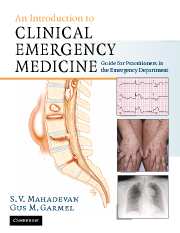Book contents
- Frontmatter
- Contents
- List of contributors
- Foreword
- Acknowledgments
- Dedication
- Section 1 Principles of Emergency Medicine
- Section 2 Primary Complaints
- Section 3 Unique Issues in Emergency Medicine
- 41 Child abuse, elder abuse, intimate partner violence
- 42 Environmental emergencies
- 43 Ethics and end-of-life issues
- 44 Legal aspects of emergency care
- 45 Occupational exposures in the emergency department
- Section 4 Appendices
- Index
43 - Ethics and end-of-life issues
Published online by Cambridge University Press: 27 October 2009
- Frontmatter
- Contents
- List of contributors
- Foreword
- Acknowledgments
- Dedication
- Section 1 Principles of Emergency Medicine
- Section 2 Primary Complaints
- Section 3 Unique Issues in Emergency Medicine
- 41 Child abuse, elder abuse, intimate partner violence
- 42 Environmental emergencies
- 43 Ethics and end-of-life issues
- 44 Legal aspects of emergency care
- 45 Occupational exposures in the emergency department
- Section 4 Appendices
- Index
Summary
Scope of the problem
Challenging ethical issues may suddenly arise when caring for critically-ill patients in the emergency department (ED). The rapid deterioration of such patients often prohibits lengthy deliberations about ethical dilemmas. Emergency physicians must possess a practical understanding of medical ethics in order to address these cases in a thorough and efficient manner.
Terminology
Modern philosophy links the definitions of morality and ethics. In the simplest forms, morality is the difference between right and wrong, while ethics represents the critical study of morality. Individuals choose from a variety of sources of moral authority, such as religion, cultural norms, politics, and law. As such, persons may regard situations or objects differently, based on the value systems espoused by their source of moral guidance. Ethics represents the cognitive evaluation of a principle or situation, acknowledging the fact that individuals possess different moral backgrounds. Ethical dilemmas arise when there is a conflict of values between persons arguing for competing moral imperatives – when people cannot agree on what is right and what is wrong.
Medical ethics is a discipline that studies differences in value systems as they apply to clinical situations. Medical ethics is most commonly taught through classroom discussion, as a means to familiarize providers with common ethical principles. Applied health care ethics is the practical extension of such discussion, recognizing that like all clinical decision-making, ethical dilemmas require action. The word “applied” then refers to the reality that physicians mediate ethical dilemmas and make tough decisions every day.
- Type
- Chapter
- Information
- An Introduction to Clinical Emergency MedicineGuide for Practitioners in the Emergency Department, pp. 653 - 660Publisher: Cambridge University PressPrint publication year: 2005



